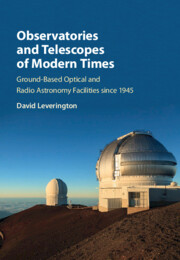 Observatories and Telescopes of Modern Times
Observatories and Telescopes of Modern Times from Part 1 - Optical Observatories
Published online by Cambridge University Press: 15 December 2016
Astronomers at the University of Arizona started planning in the early 1980s for an international observatory on the 10,700 ft (3,250 m) Mount Graham, the highest peak in the Pinaleno range, about 75 miles (120 km) from Tucson, Arizona. Mount Graham was chosen because of its low light pollution, low atmospheric water vapour, ease of access, and excellent seeing which was only a little worse than that on Mauna Kea. The planned telescopes included the 1.8 m Vatican Advanced Technology Telescope (VATT) of the Vatican Observatory, a submillimetre telescope (later called the Heinrich Hertz Submillimeter Telescope – see Section 23.6), and an optical-infrared binocular telescope, then called the Columbus Project, which consisted of two 8 m primary mirrors on a common mount.
For a time Mount Graham was also considered as a possible site for the National New Technology Telescope (NNTT, see Section 3.2). This was strongly advocated by the University of Arizona as they were hoping to supply its mirror. But Mauna Kea was eventually chosen in 1987 as its location after three years of site surveys, with Mount Graham as a backup.
Vatican Advanced Technology Telescope (VATT)
In the meantime the University of Arizona's Mirror Laboratory had spun-cast the 1.8 m, f/1.0 primary mirror blank for the VATT in 1985. In the same year construction work was also expected to begin on the VATT's new observatory building on Mount Graham, but environmental concerns over the mountain's red squirrels and its other sensitive habitats led to a series of delays.
The prospect of being able to build an astronomical observatory on Mount Graham received a major setback in June 1987 when the Mount Graham red squirrel was declared an endangered species. But it appeared as though the environmental impasse had been broken in October 1988 when university-sponsored legislation was passed by the United States Congress to allow the three planned telescopes to be built on the mountain without Forest Service approval. This legislation allowed the university to build four more telescopes, if the first three were found to have had a minimal impact on the red squirrel. But in March 1990, a Federal judge ordered a temporary halt to the observatory construction. Although this temporary injunction was overturned by the US Court of Appeals two months later, other potential legal problems had also arisen.
To save this book to your Kindle, first ensure [email protected] is added to your Approved Personal Document E-mail List under your Personal Document Settings on the Manage Your Content and Devices page of your Amazon account. Then enter the ‘name’ part of your Kindle email address below. Find out more about saving to your Kindle.
Note you can select to save to either the @free.kindle.com or @kindle.com variations. ‘@free.kindle.com’ emails are free but can only be saved to your device when it is connected to wi-fi. ‘@kindle.com’ emails can be delivered even when you are not connected to wi-fi, but note that service fees apply.
Find out more about the Kindle Personal Document Service.
To save content items to your account, please confirm that you agree to abide by our usage policies. If this is the first time you use this feature, you will be asked to authorise Cambridge Core to connect with your account. Find out more about saving content to Dropbox.
To save content items to your account, please confirm that you agree to abide by our usage policies. If this is the first time you use this feature, you will be asked to authorise Cambridge Core to connect with your account. Find out more about saving content to Google Drive.